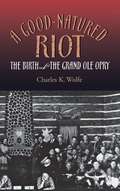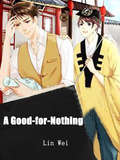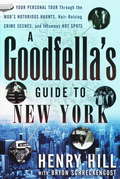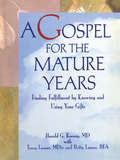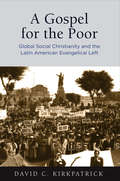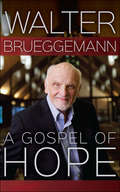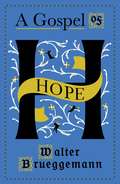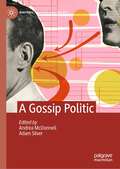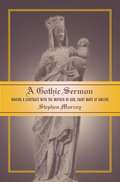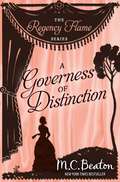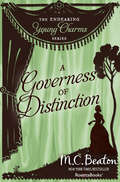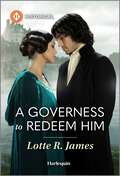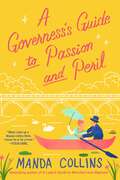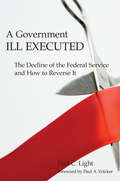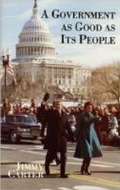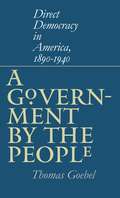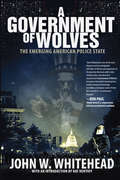- Table View
- List View
A Good-Natured Riot: The Birth of the Grand Ole Opry (Co-published with the Country Music Foundation Press)
by Charles K. WolfeWinner of the Ralph J. Gleason Music Book AwardWinner of the ASCAP Deems Taylor AwardOn November 28, 1925, a white-bearded man sat before one of Nashville radio station WSM's newfangled carbon microphones to play a few old-time fiddle tunes. Uncle Jimmy Thompson played on the air for an hour that night, and throughout the region listeners at their old crystal sets suddenly perked up. Back in Nashville the response at the offices of National Life Insurance Company, which owned radio station WSM ("We Shield Millions"), was dramatic; phone calls and telegrams poured into the station, many of them making special requests. It was not long before station manager George D. Hay was besieged by pickers and fiddlers of every variety, as well as hoedown bands, singers, and comedians—all wanting their shot at the Saturday night airwaves. "We soon had a good-natured riot on our hands," Hay later recalled. And, thus, the Opry was born.Or so the story goes. In truth, the birth of the Opry was a far more complicated event than even Hay, "the solemn old Judge," remembered. The veteran performers of that era are all gone now, but since the 1970s pioneering country music historian Charles K. Wolfe has spent countless hours recording the oral history of the principals and their families and mining archival materials from the Country Music Foundation and elsewhere to understand just what those early days were like. The story that he has reconstructed is fascinating. Both a detailed history and a group biography of the Opry's early years, A Good-Natured Riot provides the first comprehensive and thoroughly researched account of the personalities, the music, and the social and cultural conditions that were such fertile ground for the growth of a radio show that was to become an essential part of American culture.Wolfe traces the unsure beginnings of the Opry through its many incarnations, through cast tours of the South, the Great Depression, commercial sponsorship by companies like Prince Albert Tobacco, and the first national radio linkups. He gives colorful and engaging portraits of the motley assembly of the first Opry casts—amateurs from the hills and valleys surrounding Nashville, like harmonica player Dr. Humphrey Bate ("Dean of the Opry") and fiddler Sid Harkreader, virtuoso string bands like the Dixieliners, colorful hoedown bands like the Gully Jumpers and the Fruit Jar Drinkers, the important African American performer DeFord Bailey, vaudeville acts and comedians like Lasses and Honey, through more professional groups such as the Vagabonds, the Delmore Brothers, Bill Monroe and the Blue Grass Boys, and perennial favorite Roy Acuff and his Smoky Mountain Boys.With dozens of wonderful photographs and a complete roster of every performer and performance of these early Opry years, A Good-Natured Riot gives a full and authoritative portrayal of the colorful beginnings of WSM's barn dance program up to 1940, by which time the Grand Ole Opry had found its national audience and was poised to become the legendary institution that it remains to this day.
A Good-Natured Riot: The Birth of the Grand Ole Opry (Co-published with the Country Music Foundation Press)
by Charles K. WolfeWinner of the Ralph J. Gleason Music Book AwardWinner of the ASCAP Deems Taylor Award On November 28, 1925, a white-bearded man sat before one of Nashville radio station WSM's newfangled carbon microphones to play a few old-time fiddle tunes. Uncle Jimmy Thompson played on the air for an hour that night, and throughout the region listeners at their old crystal sets suddenly perked up. Back in Nashville the response at the offices of National Life Insurance Company, which owned radio station WSM ("We Shield Millions"), was dramatic; phone calls and telegrams poured into the station, many of them making special requests. It was not long before station manager George D. Hay was besieged by pickers and fiddlers of every variety, as well as hoedown bands, singers, and comedians--all wanting their shot at the Saturday night airwaves. "We soon had a good-natured riot on our hands," Hay later recalled. And, thus, the Opry was born. Or so the story goes. In truth, the birth of the Opry was a far more complicated event than even Hay, "the solemn old Judge," remembered. The veteran performers of that era are all gone now, but since the 1970s pioneering country music historian Charles K. Wolfe has spent countless hours recording the oral history of the principals and their families and mining archival materials from the Country Music Foundation and elsewhere to understand just what those early days were like. The story that he has reconstructed is fascinating. Both a detailed history and a group biography of the Opry's early years, A Good-Natured Riot provides the first comprehensive and thoroughly researched account of the personalities, the music, and the social and cultural conditions that were such fertile ground for the growth of a radio show that was to become an essential part of American culture. Wolfe traces the unsure beginnings of the Opry through its many incarnations, through cast tours of the South, the Great Depression, commercial sponsorship by companies like Prince Albert Tobacco, and the first national radio linkups. He gives colorful and engaging portraits of the motley assembly of the first Opry casts--amateurs from the hills and valleys surrounding Nashville, like harmonica player Dr. Humphrey Bate ("Dean of the Opry") and fiddler Sid Harkreader, virtuoso string bands like the Dixieliners, colorful hoedown bands like the Gully Jumpers and the Fruit Jar Drinkers, the important African American performer DeFord Bailey, vaudeville acts and comedians like Lasses and Honey, through more professional groups such as the Vagabonds, the Delmore Brothers, Bill Monroe and the Blue Grass Boys, and perennial favorite Roy Acuff and his Smoky Mountain Boys. With dozens of wonderful photographs and a complete roster of every performer and performance of these early Opry years, A Good-Natured Riot gives a full and authoritative portrayal of the colorful beginnings of WSM's barn dance program up to 1940, by which time the Grand Ole Opry had found its national audience and was poised to become the legendary institution that it remains to this day.
A Good-for-Nothing: Volume 1 (Volume 1 #1)
by Lin WeiThe little trash of the Exorcist Family had been packaged and given to someone else to be his wife.After he was deceived and humiliated.Married to his most hated enemy.Only a husband is good in this world.His family treated him like a root and his enemies treated him like a treasure.
A Good-for-Nothing: Volume 2 (Volume 2 #2)
by Lin WeiThe little trash of the Exorcist Family had been packaged and given to someone else to be his wife.After he was deceived and humiliated.Married to his most hated enemy.Only a husband is good in this world.His family treated him like a root and his enemies treated him like a treasure.
A Goodfella's Guide to New York: Your Personal Tour Through the Mob's Notorious Haunts, Hair-Raising Crime Scenes, and Infamous Hot Spots
by Henry Hill Bryon SchreckengostFans of Henry Hill, New York, or pop culture won't want to be without this gritty, funny, and informative guide through the underbelly of the world's greatest city--a personal tour of the mob's notorious haunts, hair-raising crime scenes, and infamous hot spots.
A Goodly Heritage
by Waterloo-Wellington-Perth Parochial SchoolsNative Peoples Early Explorers The Foundations Of New France English in America Through Trials and Afflictions British Conquest of Nfew France The American Revolution The Mennonites in Colonial America Exploration West The War of 1812 The American Civil War Confederation
A Goomba's Guide to Life
by Charles Fleming Steven R. SchirripaAttention would-be paesans: Can't distinguish "gabagool" from "pasta fazool"? Not sure how to properly accessorize your track suit with gold chains? Does the phrase "go to the mattresses" make you sleepy? Now Steven R. Schirripa, The Sopranos' own Bobby Bacala, exposes the inner mysteries of this unique Italian-American hybrid in A Goomba's Guide to Life so that anyone can walk, talk, and live like a guy "from the neighborhood." Über-goomba Steve Schirripa shows how being a goomba made him what he is today, offering lessons learned on his own journey from Bensonhurst to Vegas, and to his current gig as Bobby Bacala on one of TV's most popular shows. Along the way, he shares secrets that will help you get in touch with your own inner goomba. You'll learn what music to enjoy (Sinatra, yes; Snoop Dogg, no), what movies to watch (Raging Bull, yes; Titanic, never), which sports to follow (baseball is good; golf and tennis, fuhgeddaboudit), and even tips on goomba etiquette. Ever wonder how a real goomba gets the best seat in the house? (Hint: It involves tipping, jewelry, and intimidation. ) Schirripa even includes goomba do's and don'ts (never, ever criticize a goomba's mother or her gravy; always wear more jewelry than you think you need). With knockout photographs of Schirripa and his compares, and insider information on how to think goomba, speak goomba, cook and eat goomba, and even how to behave at goomba weddings and funerals, A Goomba's Guide to Life will show any wiseguy wannabe how to sing like a Soprano.
A Gorgeous Excitement: A Novel
by Cynthia WeinerOne young woman&’s summer of infinite possibility takes a turn she never saw coming in &“this 1980s coming-of-age tale [that&’s] chillingly compelling. Get ready to be transported.&”—People (Best Books of the Month) A TOWN & COUNTRY AND CRIMEREADS MOST ANTICIPATED BOOK&“I haven&’t felt this kind of excitement reading a story set in the &’80s since I first discovered Jay McInerney, Tama Janowitz, and Bret Easton Ellis.&”—Margarita Montimore, bestselling author of Oona Out of OrderThere are two things Nina Jacobs is determined to do over the summer of 1986: avoid her mother&’s depression-fueled rages, and lose her virginity before she starts college in the fall. Both are seemingly impossible—when her mother isn&’t lying in bed for days, she&’s lashing out at Nina over any perceived slight. And after a blowjob gone spectacularly wrong, Nina is the talk of Flanagan&’s, the Upper East Side bar where young Manhattan society congregates. It doesn&’t help that she&’s Jewish, an outsider among the blue-eyed blondes who populate this rarified world. She can fit in, kind of, with enough alcohol and prescription drugs stolen from her parents&’ medicine cabinet.Flanagan&’s is where she pines for the handsome, preppy, and charismatic Gardner Reed. Every girl wants to sleep with him and every guy wants to be him. After she&’s introduced to cocaine, Nina plunges headlong into her pursuit of Gardner, oblivious to the warning signs. When a new medication seemingly frees her mother from darkness, and Nina and Gardner grow closer, it seems like Nina might finally get what she wants. But at what cost?Freud called cocaine &“a gorgeous excitement,&” but a gorgeous excitement for the wrong guy can be lethal.
A Gospel for the Mature Years: Finding Fulfillment by Knowing and Using Your Gifts
by Harold G KoenigThere’s good news for middle-aged and older adults who wish to grow emotionally and spiritually and experience satisfaction and joy in their mature years regardless of circumstance, health, or age. A Gospel for the Mature Years shows you how to achieve joy and fulfillment by developing a deep, personal, intimate relationship with God, recognizing your God-given gifts, and using your abilities in service to others. Our later years are not meant to be a time for idleness and withdrawal from life. Rather, this is an exciting, meaningful, and action-packed time when we should grab hold of life and live it fully, advancing God’s kingdom in our families, communities, and nation.Meant both for individual reading and for use in churches as a workbook for small discussion groups, A Gospel for the Mature Years is arranged to facilitate use in classes running on a calendar quarter of 13 Sundays. Questions for discussion at the end of each chapter have been designed to encourage individual preparation for participation in the group. Specific topics you learn about include: emotional growth and spiritual development achievement of well-being and fulfillment achieving Christian maturity preventing depression counseling and caregiving using one’s gifts and talents overcoming barriers to loving and serving others avoiding burnout and exhaustion when loving and serving others These are increasingly difficult times, requiring that God’s people work together by utilizing their talents for the benefit of others. The authors make clear that the call to service does not end with retirement. We can use this inspirational book to identify our gifts and learn how to best use them in service to God and others. A Gospel for the Mature Years will help us produce a society of people with vision--a vision of hope that life can have meaning and purpose regardless of circumstance, and of faith that every person has been given a gift that will enable them to make a difference in this world and make it a better place for their children and grandchildren.
A Gospel for the Poor: Global Social Christianity and the Latin American Evangelical Left
by David C. KirkpatrickIn 1974, the International Congress on World Evangelization met in Lausanne, Switzerland. Gathering together nearly 2,500 Protestant evangelical leaders from more than 150 countries and 135 denominations, it rivaled Vatican II in terms of its influence. But as David C. Kirkpatrick argues in A Gospel for the Poor, the Lausanne Congress was most influential because, for the first time, theologians from the Global South gained a place at the table of the world's evangelical leadership—bringing their nascent brand of social Christianity with them.Leading up to this momentous occasion, after World War II, there emerged in various parts of the world an embryonic yet discernible progressive coalition of thinkers who were embedded in global evangelical organizations and educational institutions such as the InterVarsity Christian Fellowship, the International Fellowship of Evangelical Students, and the International Fellowship of Evangelical Mission Theologians. Within these groups, Latin Americans had an especially strong voice, for they had honed their theology as a religious minority, having defined it against two perceived ideological excesses: Marxist-inflected Catholic liberation theology and the conservative political loyalties of the U.S. Religious Right.In this context, transnational conversations provoked the rise of progressive evangelical politics, the explosion of Christian mission and relief organizations, and the infusion of social justice into the very mission of evangelicals around the world and across a broad spectrum of denominations. Drawing upon bilingual interviews and archives and personal papers from three continents, Kirkpatrick adopts a transnational perspective to tell the story of how a Cold War generation of progressive Latin Americans, including seminal figures such as Ecuadorian René Padilla and Peruvian Samuel Escobar, developed, named, and exported their version of social Christianity to an evolving coalition of global evangelicals.
A Gospel of Hope
by Walter BrueggemannBeloved and respected by scholars, preachers, and laity alike, Walter Brueggemann offers penetrating insights on Scripture and prophetic diagnoses of our culture. Instead of maintaining what is safe and routine, A Gospel of Hope encourages readers to embrace the audacity required to live out one’s faith. This must-have volume gathers Brueggemann’s wisdom on topics ranging from anxiety and abundance to partisanship and the role of faith in public life.
A Gospel of Hope
by Walter Brueggemann'Wise words ... filled with a message of hope for humanity and the world' - Irish CatholicWalter Brueggemann is beloved and respected by scholars, preachers and laity alike for his penetrating insights on Scripture and prophetic diagnoses of our culture. Both are woven throughout this new collection of his writings, A Gospel of Hope, which encourages readers to abandon what is safe and routine and instead embrace the audacity required to live out one's faith. This must-have volume gathers Brueggemann's wisdom on topics ranging from anxiety and abundance to partisanship and the role of faith in public life.
A Gossip Politic (Rhetoric, Politics and Society)
by Adam Silver Andrea McDonnellThis book makes explicit the historical, technological, and discursive links between gossip as a mode of communication, news media, and contemporary politics. A Gossip Politic advances a new framework of gossip, applying the informal understanding of the term to news talk and political actors. Authored by esteemed scholars in the fields of Political Science, Media Studies, Linguistics, and Sociology, chapters consider the influence of gossip on the press, the American presidency, and the public. A Gossip Politic provides readers with a multi-faceted portrait of the ways in which gossip has influenced media history, shaped our understanding of democracy, and contributed to our current political landscape.
A Gothic Sermon: Making a Contract with the Mother of God, Saint Mary of Amiens
by Stephen Murray"In this work, Stephen Murray seizes a rare opportunity to explore the relationship between verbal and visual culture by presenting a sermon that may have been preached during the second half of the thirteenth century in or near the cathedral of Notre-Dame of Amiens, whose sculptural program was completed at about the same time. In addition to providing a complete transcription and translation of the text, Murray examines the historical context of the sermon and draws comparisons between its underlying structure and the structure of the cathedral's Gothic portals. He also points out parallels between the rhetorical tools used in the sermon and the stylistic and compositional tools used in the sculpture. In both sermon and cathedral he finds a powerful motivational mechanism that invites the repentant sinner to enter into a new contract with the Virgin Mary. "--BOOK JACKET. Title Summary field provided by Blackwell North America, Inc. All Rights Reserved
A Gothic Treasury of the Supernatural: Six Novels
by Henry James Robert Louis Stevenson Oscar Wilde Horace Walpole Bram Stoker Mary ShelleyA GOTHIC TREASURY OF THE SUPERNATURAL. What sends chills down our spine when we read a good horror story? Contrary to some modern trends, it is not merely how much blood is spilled or how grotesquely an alien creature or monster is portrayed. Rather, the thrill of terror comes in exploring the depths of the human soul and in discovering the capacity for evil that lies hidden there: the monsters that lurk within us are the most frightening ones of all. These six gothic masterpieces of supernatural horror and suspense provide a wealth of such terrors. The first true gothic novel appeared in 1764: Horace Walpole's The Castle of Otranto. Inspired by a dream in which Walpole saw a huge, armored hand in an ancient castle, the story contains all the elements that have become the earmarks of the gothic novel: a medieval castle, a lost heir who must prove himself in order to claim his fortune, a villain, a love interest, and various supernatural phenomena. The Castle of Otranto influenced countless literary works throughout the nineteenth century. In Geneva during the summer of 1816, Lord Byron, John Polidori, Percy Bysshe Shelley, and Mary Wollstonecraft Godwin (later Mary Shelley) amused one another by making up ghost stories. Mary Shelley's tale was the seed from which her timeless novel Frankenstein grew. Subtitled The Modern Prometheus, it is the spellbinding story of Victor Frankenstein, a doctor who plays God by creating a living being from the bodies of the dead; the tragic monster is ultimately seen as Frankenstein's alter ego. A similar theme appears in The Strange Case of Dr. Jekyll and Mr. Hyde. A doctor discovers a potion that has the power to transform him into a fiend whose deeds become more and more horrifying. Awakened by a nightmare, Robert Louis Stevenson feverishly wrote Dr. Jekyll and Mr. Hyde in three days, destroyed it, and wrote it again in another three days. In Dracula, Bram Stoker created a monstrous being founded in folklore and legend; it is a tale made the more horrifying by the enduring belief in the possible existence of real vampires. With superhuman power, the vampire Count Dracula lures victims into his clutches and drains them of life until they too join the living dead. Oscar Wilde portrays a beautiful, ever-youthful Adonis who leads a life of decadence in The Picture of Dorian Gray. As Dorian ruins and corrupts those around him, his portrait strangely alters with each new crime he commits. We follow him down this path of decay to a shattering, inevitable climax. In The Turn of the Screw, Henry James, the master of ambiguity, tells the story of a governess, her two charges, and the spiritual presence of a dead valet and a dead governess. If we cannot be sure that these ghosts are real or imagined, there is no doubt about the terror this tangled tale inspires. Complete and together in one volume, these six gothic classics of the supernatural, by great writers who are masters of the macabre, provide new insights--and heightened terrors--with each reading.
A Governess of Distinction (Regency Flame #3)
by M.C. BeatonThe third book in M.C. Beaton's charming Regency Flame series. Lord Percy Hunterdon despaired: he had inherited a Gothic horror of an estate along with a pair of fifteen-year-old brats to marry off. It was no secret to him that finding husbands for these two vile young ladies would require the utmost expertise: the care of a governess of superior caliber.When Jean Morrison spied Lord Percy's advertisement, dreams of an unmarried viscount and a magnificent castle danced in her head. She imagined him as Byronic and brooding, pacing the battlements with a black cloak wrapped around his manly shoulders. And naturally, he would fall madly in love with her.Her dream burst apart at the seams immediately when she encountered dank, dirty Trelawney Castle and encountered for the first time the evil dispositions of her new charges. Still, despite all of this, the golden hair and dancing eyes of her employer conjured up fantasies that were most unseemly for a governess of distinction.Searching for lighter romances set in the English countryside? Look no farther than the Regency Flame Series, which features mistaken identities, botched marriages, witty heroines, and the courtship of prime Corinthians.
A Governess of Distinction (The Endearing Young Charms Series #4)
by M. C. BeatonA young governess in search of a dream life discovers that grim reality can bring true love in the New York Times–bestselling author’s Regency romance.Lord Percy Hunterdon has inherited a Gothic horror of a country estate along with a pair of teenage brats to marry off. To survive this disastrous fortune, he requires the expertise of a superior governess.When Jean Morrison discovers Lord Hunterdon's advertisement, dreams of an unmarried viscount and a magnificent castle dance in her head. She imagines him as Byronic and brooding, pacing the battlements in a black cloak and falling madly in love with her.It’s a rude awakening when Jean first sees the dank Trelawney Castle and encounters her vile new charges. Still, the golden hair and dancing eyes of her employer conjure up fantasies that are most unseemly for a governess of distinction.
A Governess to Redeem Him
by Lotte R. JamesWhat happens when a governess&’s first love comes back from the dead? Find out in this Gothic second-chance romance. To claim their future They must rewrite their past… Eighteen years ago, Juliana Myles fled her home and built a new life as a governess, believing her childhood sweetheart had been sentenced to death! Now Sebastian Lloyd is back from the dead and wants Juliana&’s help in proving his innocence… Sebastian has spent a lifetime running from an unjust verdict. But he&’s tired of being haunted by his past. Yet working with Juliana to capture the true culprit also means being confronted by searing memories of their passionate history. And the temptation to bring their love story back to life…From Harlequin Historical: Your romantic escape to the past.
A Governess's Guide to Passion and Peril (Ladies Most Scandalous #4)
by Manda CollinsTwo friends reunite—and discover hidden feelings—while investigating a murder in this sensual, witty historical romance perfect for fans of Evie Dunmore and Netflix's Bridgerton! Jane Halliwell once dreamed of a home of her own—but those dreams (and her dowry) died with her father. Now, she works as a governess, preparing her charge for a future no longer within her reach. When her employer is murdered during a house party, however, Jane is forced back into the world of the ton. But stepping in as hostess will require working with the same lord who once broke her girlish heart. Lord Adrian Fielding was too consumed with his job at the Foreign Office to pay young Jane much heed, but he always considered her a friend. Which is why he&’s confounded by her icy demeanor now. More troubling still is his desire to melt the tensions between them. But his mentor&’s murder means he must first find the culprit—and ensure Jane&’s safety as she manages a house full of foreign dignitaries. Only Jane insists on joining the investigation, and Adrian, despite all his diplomatic skills, finds himself seduced by her sharp wit and sparkling eyes. But with a vicious killer circling ever closer, will it soon be too late for their chance at forever?
A Governess's Guide to Passion and Peril: a fun and flirty historical romcom, perfect for fans of Bridgerton (A Lady's Guide)
by Manda CollinsTwo friends reunite - and discover hidden feelings - while investigating a murder in this sensual, witty historical romance perfect for fans of Evie Dunmore and Netflix's Bridgerton!Jane Halliwell once dreamed of a home of her own - but those dreams, along with her dowry, died with her father. Now, she works as a governess, preparing her charge for a future no longer within her reach. However, when her employer is murdered during a house party, Jane is forced back into the world of the ton. But stepping in as hostess will require working with the same lord who once broke her girlish heart.Lord Adrian Fielding was too consumed with his job at the Foreign Office to pay young Jane much heed, but he always considered her a friend. Which is why he's confounded by her icy demeanour now. More troubling still is his desire to melt the tensions between them. But his mentor's murder means he must first find the culprit - and ensure Jane's safety as she manages a house full of foreign dignitaries.Only Jane insists on joining the investigation and Adrian, despite all his diplomatic skills, finds himself seduced by her sharp wit and sparkling eyes. But with a vicious killer closing in, will it soon be too late for their chance at forever?Praise for Manda Collins:'Witty, intelligent, and hard to put down' Rachel Van Dyken'Manda Collins heats up the ballroom and writes romance to melt even the frostiest duke's heart' Tessa Dare'Utterly charming' Popsugar'Manda Collins is a delight!' Elizabeth Hoyt'Mystery, romance, and an indomitable heroine make for a brisk, compelling read' Madeline Hunter'Sexy and smart historical romance, with a big dash of fun' Vanessa Kelly'Sexy, thrilling, romantic . . . Manda Collins makes her Regency world a place any reader would want to dwell' Kieran Kramer
A Government Ill Executed: The Decline of the Federal Service and How to Reverse It
by Paul C. LightThe federal government is having increasing difficulty faithfully executing the laws, which is what Alexander Hamilton called “the true test” of a good government. This book diagnoses the symptoms, explains their general causes, and proposes ways to improve the effectiveness of the federal government. Employing Hamilton’s seven measures of an energetic federal service, Paul Light shows how the government is wanting in each measure. After assessing the federal report card, Light offers a comprehensive agenda for reform, including new laws limiting the number of political appointees, reducing the layers of government management, reducing the size of government as its baby-boom employees retire, revitalizing the federal career, and reducing the heavy outsourcing of federal work. Although there are many ways to fix each of the seven problems with government, only a comprehensive agenda will bring the kind of reform needed to reverse the overall erosion of the capacity to faithfully execute all the laws.
A Government Out of Sight
by Brian BaloghWhile it is obvious that America's state and local governments were consistently active during the nineteenth century, a period dominated by laissez-faire, political historians of twentieth-century America have assumed that the national government did very little during this period. A Government Out of Sight, first published in 2009, challenges this premise, chronicling the ways in which the national government intervened powerfully in the lives of nineteenth-century Americans through the law, subsidies, and the use of third parties (including state and local governments), while avoiding bureaucracy. Americans have always turned to the national government - especially for economic development and expansion - and in the nineteenth century even those who argued for a small, nonintrusive central government demanded that the national government expand its authority to meet the nation's challenges. In revising our understanding of the ways in which Americans turned to the national government throughout this period, this study fundamentally alters our perspective on American political development in the twentieth century, shedding light on contemporary debates between progressives and conservatives about the proper size of government and government programs and subsidies that even today remain 'out of sight'.
A Government as Good as Its People
by Jimmy Carter"This volume presents sixty-two of the best and most notable public statements made by Jimmy Carter on his way to becoming president of the United States. Included are formal speeches on specific issues, such as "Pardon Yes, Amnesty, No" delivered in Seattle, Washington, August 24, 1976; news conferences like the one on "Ethnic Purity" conducted for the American Society of Newspaper Editors in Washington, D.C., April 13, 1976; informal remarks made to political gatherings; interviews (including the controversial Playboy interview from November 1976); and excerpts from the debates with President Ford." "Available again in paperback, this sampling of President Carter's philosophy is extremely readable. Carter's public pronouncements address the major concerns of our time - crime, taxes, technology, poverty, nuclear energy, world order, foreign policy, urban sprawl, human rights, the American family - and collectively stand as a testament to his deeply held conviction that we still can, and must, have "a government as good as its people.""--BOOK JACKET. Title Summary field provided by Blackwell North America, Inc. All Rights Reserved
A Government by the People: Direct Democracy in America, 1890-1940
by Thomas GoebelBetween 1898 and 1918, many American states introduced the initiative, referendum, and recall--known collectively as direct democracy. Most interpreters have seen the motives for these reform measures as purely political, but Thomas Goebel demonstrates that the call for direct democracy was deeply rooted in antimonopoly sentiment. Frustrated with the governmental corruption and favoritism that facilitated the rise of monopolies, advocates of direct democracy aimed to check the influence of legislative bodies and directly empower the people to pass laws and abolish trusts. But direct democracy failed to achieve its promises: corporations and trusts continued to flourish, voter turnout rates did not increase, and interest groups grew stronger. By the 1930s, it was clear that direct democracy favored large organizations with the financial and organizational resources to fund increasingly expensive campaigns. Recent years have witnessed a resurgence of direct democracy, particularly in California, where ballot questions and propositions have addressed such volatile issues as gay rights and affirmative action. In this context, Goebel's analysis of direct democracy's history, evolution, and ultimate unsuitability as a grassroots tool is particularly timely.
A Government of Wolves: The Emerging American Police State
by Nat Hentoff John W. Whitehead"A NATION OF SHEEP WILL BEGET A GOVERNMENT OF WOLVES"-EDWARD R. MURROW America is fast moving into a state of lockdown. Surveillance cameras, drug-sniffing dogs, SWAT team raids, roadside strip searches, blood draws at DUI checkpoints, mosquito drones, tasers, privatized prisons, GPS tracking devices, zero tolerance policies, overcriminalization, free speech zones-these are all symptoms of the emerging police state in America. A GOVERNMENT OF WOLVES paints a chilling portrait of a nation in the final stages of transformation into outright authoritarianism, whose citizens have become little more than a nation of suspects to be cowed, corralled, and controlled. Pulling from his extensive knowledge of constitutional law, history, and futuristic films, John W. Whitehead helps readers navigate this treacherous terrain and provides them with a blueprint for hopefully finding their way back to freedom.
